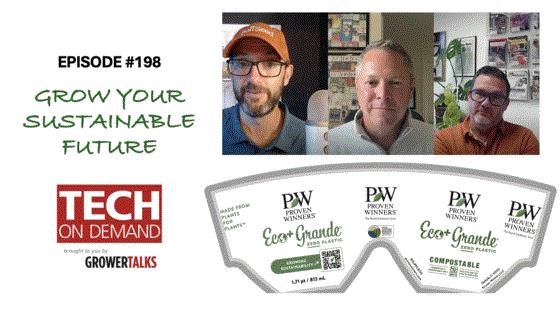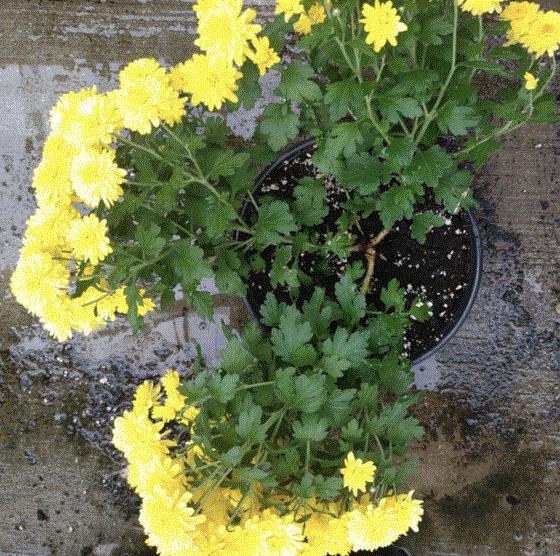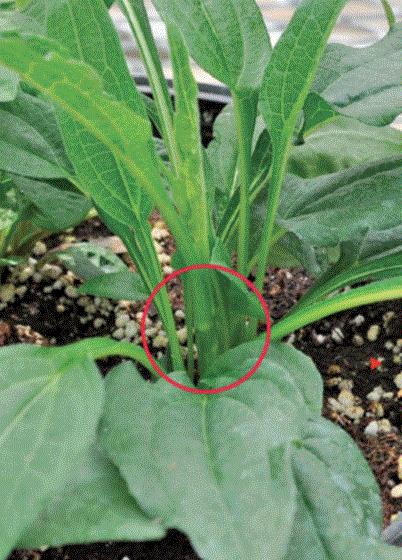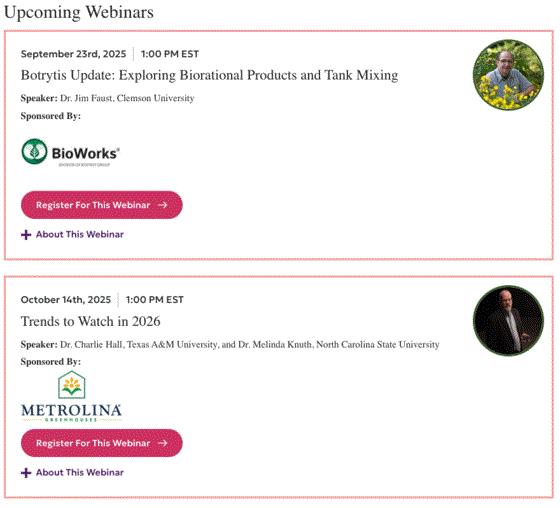PODCAST 198! Grow Your Sustainable Future with Proven Winners
NOTE: This writeup in no way covers all that we got into during this hour-long podcast. You really need to listen to the full episode.
Sustainability and environmental responsibility are high on the priority list for the Proven Winners team and their partners. Their new Eco+ plastic-free and industrial compostable pots are a key part of this plant-powered package. To learn more, I caught up with Proven Winners’ director of sales, Dave Konsoer and Danny Mishek, president of VistaTek, the award-winning manufacturing company behind the new pots and other plant-based, compostable products making their way into many industries.

We discussed all aspects of the new packaging, from manufacturing and trialing to ensure integrity in greenhouse environments, to seamless integration into crop production systems, and the strong, branded retail presence for which Proven Winners is known. Dave clearly explained the reasons Proven Winners invested in the move to sustainable packaging, and Danny articulated why a zero-plastic approach is not only responsible but becoming necessary due to new regulations being implemented in many states very soon.
Of course, the pots went through many iterations in development—and functionality in greenhouse production and retail settings was non-negotiable. Dave stated there are no changes to how you grow crops in Eco+ pots, and the brand messaging remains crisp and clear on the plastic-free material, as we’d all expect from Proven Winners.
Danny explained regulatory changes coming quickly in many states and why bio-based materials and plastic-free pots like Proven Winners’ Eco+ will help growers stay ahead of “extended producer responsibility” laws. Plus, as Dave explained, consumers clearly want responsible packaging and look to Proven Winners as a leader in the gardening space. The company’s social media pages for gardeners are filled with positive comments about the new plastic-free packaging.
There’s so much fantastic information in this podcast and excellent discussion around the topic of sustainability. It’s steeped in real-world horticultural knowledge of supply chains, price sensitivity, production situations, tolerance for change and future plans. You really have to listen all the way to the end because the ideas and info just keep coming.
If a one-hour podcast on the topic isn’t enough, here are a handful of resources to check out:
Listen on all the major podcast apps! Links to Spotify and Apple Podcasts are below. And make sure you subscribe so you never miss an episode. If you can, leave a positive review to help us reach more greenhouse professionals. Lastly, jump back into the archives because we have 197 more episodes covering a huge range of topics.

Nick’s Tip of the Week: Mum Lodging & Shoot Breakage
Each week, I’ll work with my buddy Nick Flax, a technical services expert at Ball, to share a concern that’s come up during one of his numerous calls with growers across North America. This week he’s sharing a garden mum issue he addressed with growers recently, in an effort to help you and your team answer some questions and prepare for 2026.
PROBLEM: I’ve already seen some pretty fantastic mums at local garden centers over the last couple weeks. Hopefully, some of the tips and tricks shared in the Tech On Demand newsletter and in the Greenhouse Tech Team Facebook group have helped your team get out in front of issues throughout the season.
While it's crucial you stay vigilant with disease management right now, another problem comes up every year around now. And although 2025 hasn’t been as bad as past years, our group always hears reports of lodging (a.k.a. shoot breakage along the main stem). It’s never pleasant to see big, colorful mums falling apart, but unfortunately, it’s also tough to manage after the fact.

NICK’S TIP: In general, lodging is caused by a weak union between the main stem of a mum and its axillary (side) shoots. There are a few things you can do to reduce lodging, but a good chunk of this week’s tip will focus on best practices for 2026. Here are two key factors that affect lodging:
Plant architecture. If a plant’s branch angle (relative to the main stem) is too wide, the chances of lodging are much greater. As mums develop, each branch can get weighty—especially on your biggest mums, or plants that are being overhead watered or getting rained on. While I’ve never seen research or data that indicates what the strongest branch angle is for mums and other herbaceous crops, a 60° to 70° angle from the trunk is regarded as the optimal range for strong branch unions in trees. As such, it’s reasonable to say this is a good target to shoot for producing crops with a strong branching habit like mums (main stem is 0°; measure between stem and top of a branch).
For example, if 1 plant per pot (ppp) mums in 8- to 9-in. pots are pinched too hard and only three or four nodes remain, these shoots will grow outward at a relatively obtuse angle (about 80°) as the plant fills out. This means each branch is supporting 25 to 33% of the plant’s weight at finish. That is a LOT of mum being held up by an architecturally weak branch union, so very little force is needed to break that shoot off from the main stem. If you pinch your mums, be sure to leave at least 5 to 7 nodes below the pinch to promote a more upright branch angle and reduce the load on any given branch at finish, especially in your 1 ppp mums.
Fertilizer management. Failing to change fertilizer formulations as mums mature and over-feeding mums at finish are common fertilizer management practices that encourage lodging.
Applying ammonia-based fertilizers through the first half to two thirds of the production cycle is considered good practice, but using this class of fertilizers late in production encourages plants to remain soft, which increases the risk of breakage. Switch to a more nitrate-based fertilizer (your favorite Cal-Mag) once that “roundy-moundy” architecture is well-established to reduce the risk of lodging at finish.
Heavy feeding late in production encourages mums to remain soft, regardless of the main nitrogen source. By the time plants reach visible bud, they don’t need much more fertilizer because they're essentially done growing and just need to finish developing (basically just need to push water into already existing cells, not create new ones).
-
Excess ammoniacal nitrogen often encourages lush growth below the bud set and can cause leaf size and overall shoot weight to continue increasing.
-
Excess nitrates, on the other hand, cause leaves and stems to become “crunchy” and brittle as the plant sequesters the unused nitrogen.
If your mums are soft and lodging but you’re still applying feed, switch to clear water only from here on out. In the future, begin tapering off your fertilizer program as plants reach visible bud to help combat this tendency.
If your mum architecture is good but plants are still lodging and you’re losing plants at ship or retail, consider the following options to help combat further losses:
-
Stake and tie or install cages to help keep shoots from breaking and falling. If caging is the route you go, be sure to use two-piece/split cages to avoid bunching the canopy in order to pass it through the rings.
-
Lower the air temperature in your production area (if growing or holding plants in a greenhouse) to encourage better tone and help reduce the likelihood of lodging.
-
Apply a PGR drench to stop any last-minute growth your mums are doing and help improve tone. This late in the season, 1 to 2 ppm of paclobutrazol is more than enough to do the trick. Note that using a rate above this won’t enhance the effect—it’ll just cost you more in total PGR used.

Forcing Seed Echinacea for Spring Sales
I was talking with some folks about seed perennials this week and echinacea came up because echinacea (in general) are trending, and adding some of the cool seed versions to you mix might be a way to expand your 2026 range. I looked for some resources to share and immediately found an article by two brilliant perennials experts, breeder Bin Liu and global product manager Cor de Jong. This dynamic duo covered strategies to bring seed echinacea into color to hit spring (and fall) markets.

The authors rightly point out that echinacea (and many other perennials) continue to increase in importance based on consumer demand, and that both times of year are appropriate to showcase their bright colors and classic forms. Now is a great time to order seed perennials and round out your assortment with some fresh takes on top perennial classes.
Tak a look at the FULL ARTICLE and the highlights below—maybe share this with your perennials team and bookmark it for future use.
Using long days to produce echinacea for Mother’s Day sales is the strategy du jour and the authors offer these tips:
-
Double check you have natural short days in your planned growing area when you transplant the 288 with the two true leaves until you reach the seven true leaves stage.
-
Supplemental long-day lighting starts from a minimum seven true leaf stage to visible knot stage.
-
Daylength for long-day treatment can be daylength extension to 14 hours or night interruption from 10 p.m. to 2 a.m.
-
Long-day treatment should be applied to quart or larger containers. On smaller sizes, such as 72- or 50-cell trays, it could delay flowering and cause less flower uniformity.
Getting echinacea ready for fall requires short-day growing. Here are the key points:
-
Implement a six-week short-day treatment from two to seven full-unfolded-true-leaf stage or purchase a short-day-grown plug from your plug supplier.
-
Daylength for the short-day treatment can be from 10 to 12 hours.
-
Short-day treatment can be applied to 72- or-50 plug trays, packs or even finished containers.

Grower Math: How Cost Accounting Boosts Profitability
Cost accounting is the process of calculating your fixed and variable costs of production and identifying on what products and activities you are spending your resources. It may not be glamorous, but taking the time for cost accounting can dramatically improve your business’s profitability.

Ball Seed’s senior business analyst Stephen Steiner joined me for a quick crash course in “grower math.” Stephen discussed simple ways to calculate costs (fixed and variable) by sharing greenhouse production-based examples. Knowing the true cost to produce various inputs will help you and your team make the smartest—and most profitable—decisions.
WATCH THE VIDEO!
This discussion is actually a condensed version of a much more in-depth presentation Stephen and Ball Seed’s senior commercial director Jim Kennedy have shared at events over the past couple of years. The response is always excellent, and many growers have commented about how much this relatively simple approach to what can be complex and intimidating has helped their team plan for profit. You can find the full deck HERE.
Stephen also recommends a series of GrowerTalks’ articles written by business columnist Bill Swanekamp digging deeper into greenhouse cost accounting from many angles. You can find all of the articles and more resources HERE.

TWO Upcoming Webinars (that both look excellent …)
I see that our friends at American Floral Endowment (AFE) have two free webinars on the agenda that both cover important topics—although very different ones. One covers new research into biorational fungicides for Botrytis, and the other is all about 2026 trends (from an economic perspective).

First up on September 23 (next week!) is BOTRYTIS UPDATE: EXPLORING BIORATIONAL PRODUCTS AND TANK MIXING, presented by Dr. Jim Faust at Clemson. According to the published description, he will share the latest AFE-funded research on using biorational fungicides effectively—on their own or in combination with other products. You’ll learn how to maximize efficacy, ensure compatibility and make informed rotation decisions that protect crops and reduce your use of conventional fungicides.
Next is a free webinar scheduled for October 14 with Dr. Charlie Hall (Texas A&M) and Dr. Melinda Kluth (NC State). They’ll cover TRENDS TO WATCH IN 2026. Also from the published description, you can expect to explore economic predictions, consumer preferences, and industry-specific trends to help you stay ahead of the curve in 2026.
To register and learn more, click the webinar links above or visit AFE’s GROW PRO WEBINAR PAGE.

Finish Line …
Geez, it’s been a crazy week. When it rains, it pours … Not literally, because at least here in Cleveland, we haven’t seen rain in weeks—but from a work and life perspective, it’s been a whirlwind. One reason is that I recorded eight videos and podcasts in the past week. That means a lot of editing to do but more importantly tons of great resources for you!
Here’s what you can expect in the very near future. The PW and cost accounting episodes above are part of the menu, in addition to crop-specific videos covering begonias, calibrachoa, ornamental peppers and pentas. I also recorded a podcast yesterday about biocontrol strategies for propagation, and dropped a YouTube short covering purpling on garden mum foliage.
The content is solid—I promise. But what I enjoyed most was the opportunity to talk to smart people about their areas of expertise and horticultural passions. Every single guest I talked to lived up to this statement. Shout out to Jamie Gibson and Brian Krug at Syngenta Flowers; Josh Henry, Chris Ferguson and Stephen Steiner at Ball Seed; Kristen Fowler at Koppert; Danny Mishek at VistaTek and Dave Konsoer at Proven Winners.
That’s it for this week. I drove past a local farm with the entire frontage covered in garden mums and pumpkins yesterday and started to get excited for fall. Hopefully you are, as well. I don’t do pumpkin spice, but I definitely do apple cider donuts and mums … as soon as the weather cools off a bit.
Until next week … hoping for some rain here in the Midwest—but not in my life.




Please feel free to send your comments, constructive criticism and topic ideas to me at bcalkins@ballhort.com.

Bill Calkins
Editor - Tech On Demand
This email was received by you and 25,511 other fine subscribers!
If you're interested in advertising in Tech On Demand, contact Kim Brown ASAP and she'll hook you up.